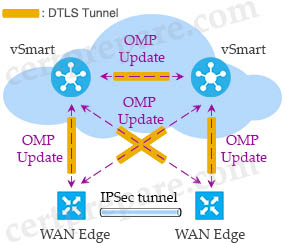SD-WAN & SD-Access Solutions 3
Question 1
Explanation
Cisco SD-WAN uses Overlay Management Protocol (OMP) which manages the overlay network. OMP runs between the vSmart controllers and WAN Edge routers (and among vSmarts themselves) where control plane information, such as the routing, policy, and management information, is exchanged over a secure connection.

Question 2
Explanation
SDA supports two additional types of roaming, which are Intra-xTR and Inter-xTR. In SDA, xTR stands for an access-switch that is a fabric edge node. It serves both as an ingress tunnel router as well as an egress tunnel router.
When a client on a fabric enabled WLAN, roams from an access point to another access point on the same access-switch, it is called Intra-xTR. Here, the local client database and client history table are updated with the information of the newly associated access point.
When a client on a fabric enabled WLAN, roams from an access point to another access point on a different access-switch, it is called Inter-xTR. Here, the map server is also updated with the client location (RLOC) information. Also, the local client database is updated with the information of the newly associated access point.
Question 3
Question 4
Explanation
The tunneling technology used for the fabric data plane is based on Virtual Extensible LAN (VXLAN). VXLAN encapsulation is UDP based, meaning that it can be forwarded by any IP-based network (legacy or third party) and creates the overlay network for the SD-Access fabric. Although LISP is the control plane for the SD-Access fabric, it does not use LISP data encapsulation for the data plane; instead, it uses VXLAN encapsulation because it is capable of encapsulating the original Ethernet header to perform MAC-in-IP encapsulation, while LISP does not. Using VXLAN allows the SD-Access fabric to support Layer 2 and Layer 3 virtual topologies (overlays) and the ability to operate over any IP-based network with built-in network segmentation (VRF instance/VN) and built-in group-based policy.
Reference: CCNP and CCIE Enterprise Core ENCOR 350-401 Official Cert Guide



question 2. I cannot find any information on fast roam. Could you please provide a reference to this question?
Q2, the answer should be inter-xTR. https://www.ciscolive.com/c/dam/r/ciscolive/us/docs/2018/pdf/BRKEWN-2020.pdf
Page 39, 76-77,
Someone please verify.
@contoso @digitaltut I agree answer to Q2 should be inter-XTR
https://www.cisco.com/c/en/us/td/docs/wireless/controller/9800/config-guide/b_wl_16_10_cg/mobility.html
When a client on a fabric enabled WLAN, roams from an access point to another access point on the same access-switch, it is called Intra-xTR. Here, the local client database and client history table are updated with the information of the newly associated access point.
When a client on a fabric enabled WLAN, roams from an access point to another access point on a different access-switch, it is called Inter-xTR. Here, the map server is also updated with the client location (RLOC) information. Also, the local client database is updated with the information of the newly associated access point.
@Razor: Thanks, good find.
https://www.cisco.com/c/dam/en/us/td/i/300001-400000/350001-360000/355001-356000/355781.jpg
@digitaltut: Can you verify and update for Q2? thanks.
ADMIN……………………………………please verify the Q 2
@all: Thanks for your detection, we updated Q.2.
Where are the Questions ?
Where are the questions please?
ANYONE PASSED EXAM FROM HERE IN 2025?